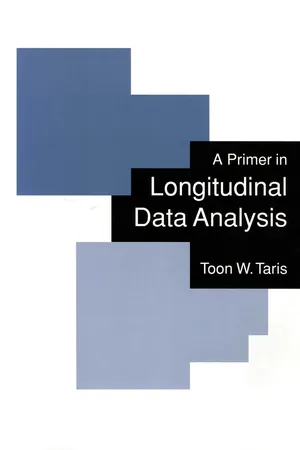Psychology
Longitudinal Research
Longitudinal research involves studying the same group of individuals over an extended period to observe changes and continuity in their behavior, traits, or development. This method allows researchers to track patterns and identify causal relationships over time, providing valuable insights into how individuals change and develop.
Written by Perlego with AI-assistance
Related key terms
Related key terms
1 of 4
Related key terms
1 of 3
12 Key excerpts on "Longitudinal Research"
- Bart L. Weathington, Christopher J. L. Cunningham, David J. Pittenger(Authors)
- 2017(Publication Date)
- Wiley(Publisher)
longitudinal designs is to examine how behavior, attitudes, or other outcomes change over time. Developmental psychologists have long used these techniques to examine the systematic changes in children’s behavior. Longitudinal designs are also popular in other areas of research, such as clinical psychology where the researchers wish to study the development of different behavioral and emotional disorders or the risk of relapse after treatment.The fundamental feature of a longitudinal design is relatively straightforward. The researcher identifies a sample of participants and then arranges to monitor their behavior, for example, over a predetermined period of time. For example, a developmental psychologist may be interested in the emotional development of children whose parents use day-care or preschool programs and children who spend most of their preschool years at home with an adult. As another example, a clinical psychologist may study the long-term effectiveness of substance-abuse treatment programs. In each case, the researcher would identify the appropriate sample of participants to study and then measure the appropriate dependent variables several times afterward. The developmental psychologist would examine the children’s emotional development as they begin and progress through kindergarten and the first elementary grades. The clinical psychologist would routinely evaluate the clients for evidence of a relapse or other problems. The decision of what timeframe to use for a longitudinal study should be taken with care and take into account logistical constraints as well as the research question that you are trying to answer.During the past two decades, psychologists have become extremely interested in Longitudinal Research methods due to the development and application of new statistical methods to analyze the data from these types of studies. As you will soon learn, these new statistical tests make the Longitudinal Research design an extremely useful research tool. Before we describe these new statistics, we should first examine the foundations of the longitudinal design.- eBook - ePub
- Elisabetta Ruspini(Author)
- 2003(Publication Date)
- Routledge(Publisher)
Part I Longitudinal Research
Passage contains an image
1 What is Longitudinal Research?
The term ‘longitudinal’ will be used here to describe what can be defined as the minimum common denominator of a family of those methods which tell us about change at the individual micro level (Zazzo, 1967; Menard, 1991). This family is the opposite of that described by the term ‘cross-sectional research’.‘Longitudinal’ is a rather imprecise term. Longitudinal data can be defined as data gathered during the observation of subjects on a number of variables over time. This definition implies the notion of repeated measurements (van der Kamp and Bijleveld, 1998). Basically, longitudinal data present information about what happened to a set of units (people, households, firms, etc.) across time. The participants in a typical longitudinal study are asked to provide information about their behaviour and attitudes regarding the issues of interest on a number of separate occasions in time (called the ‘waves’ of the study) (Taris, 2000). In contrast, cross-sectional data refer to the circumstances of respondents at one particular point in time (I shall expand on these points later). Thus, the term ‘longitudinal’ refers to a particular type of relationship between phenomena: the type which evolves over the course of time and is termed diachronic, the opposite of synchronic - eBook - ePub
- Emily Gilbert(Author)
- 2023(Publication Date)
- SAGE Publications Ltd(Publisher)
1 What is Longitudinal Research?Overview of content
This chapter will provide you with the fundamental and basic information about longitudinal studies. It will answer the key question, ‘What is a longitudinal study?’ and then explain the advantages and disadvantages of using a longitudinal methodology to conduct research.Some of the advantages and disadvantages introduced in this chapter will be expanded on further in separate chapters in this book, and this is signposted where necessary.As well as a practical explanation of longitudinal studies, the chapter will also provide a short introduction to one of the major theoretical issues associated with longitudinal studies – developing a theory of change.Learning outcomes
After you have read this chapter, you will be able to:- understand what a longitudinal study is;
- describe the benefits of carrying out research using a longitudinal methodology;
- describe the drawbacks of longitudinal studies;
- understand what a theory of change is.
What is a longitudinal study?
At its most basic, alongitudinal studyis one that follows the same subjects over time, taking repeated measures from them. By taking repeated measurements over time, a longitudinal study is a method by which to study change. Longitudinal studies can last weeks, months or even years. By following the same subjects for so long, researchers can see how different things change or stay the same over time, such as attitudes, behaviours, health conditions, educational or career paths, or relationships and family structure. This stability or change can also be looked at in relation to past events or experiences, establishing how certain events and experiences can impact on various outcomes.The subjects followed by longitudinal studies are called ‘sampling units’. Sampling units are the single items that make up the population of interest. Thepopulation - eBook - ePub
- Karin Sanders, Julie Cogin, Hugh Bainbridge, Karin Sanders, Julie A. Cogin, Hugh T.J. Bainbridge(Authors)
- 2013(Publication Date)
- Routledge(Publisher)
Longitudinal ResearchTimothy C. BednallAfter reading this chapter, we expect you to be able to:- Understand the added value of using a Longitudinal Research design;
- Be able to design a longitudinal study, including the number, spacing, and timing of assessments;
- Gain an understanding of strategies for recruiting and retaining participants;
- Understand strategies for dealing with missing data;
- Test the assumption of longitudinal measurement equivalence;
- Understand the three major families of Longitudinal Research.
1 . Introduction
Longitudinal Research refers to studies that investigate change over time. Usually, such studies involve repeated assessments of one or more variables of interest. This chapter provides an introduction to Longitudinal Research designs and discusses them within a structural equation modeling (SEM) framework. It discusses methodological challenges associated with developing and testing longitudinal models, and presents strategies for overcoming them. It provides an overview and examples of three major families of Longitudinal Research: (1) change score models, (2) autoregressive and cross-lagged panel models, and (3) latent growth models. Applications of these basic models are discussed. Other approaches to longitudinal data analysis are also briefly reviewed.2 . What is the Added Value of Longitudinal Research?
Longitudinal Research offers numerous advantages over cross-sectional studies, in which data is collected only at a single point in time. In general, longitudinal studies allow researchers to determine how individuals typically change over time, including whether change is swift or gradual, and whether the rate of change remains constant. They permit researchers to determine whether other factors predict differences - eBook - ePub
The SAGE Handbook of Personality and Individual Differences
Volume I: The Science of Personality and Individual Differences
- Virgil Zeigler-Hill, Todd K. Shackelford, Virgil Zeigler-Hill, Todd K. Shackelford(Authors)
- 2018(Publication Date)
- SAGE Publications Ltd(Publisher)
17 Longitudinal Data Analysis for Personality PsychologistsSteffen NestlerPersonality psychologists typically assume that social behavior varies as a function of personality, features of the social situation, or both personality and features of the social situation (e.g., Asendorpf and Neyer, 2012; Mischel and Shoda, 1995). Furthermore, it is posited that the social behavior in turn has a number of consequences for the development of, for example, an individual's personality, her attitudes, her perceptions of the social situation, and her social relationships. For instance, it is argued that agreeable individuals become more popular the longer one knows them (Selfhout et al., 2010), that narcissists are liked less the more one becomes familiar with them (Back et al., 2010; Küfner et al., 2013), and that members of couples influence each other in their relationship satisfaction (see Dyrenforth et al., 2010).To investigate such research questions, personality psychologists rely on data stemming from laboratory experiments or cross-sectional surveys. Another data source they use is longitudinal data (also called repeated measurements or panel data) that arise when units provide responses on multiple occasions. In contrast to experimental and cross-sectional survey data, longitudinal data has a number of merits. First, longitudinal data allows a researcher to track within-person change in a variable over time. For example, longitudinal data allows a researcher to examine the longitudinal development of specific personality traits such as neuroticism. Second, longitudinal data advances our knowledge about between-person differences in these changes and about the determinants and consequences of these differences. For example, one can examine whether specific life events (e.g., contact with an outgroup member), life course transitions (e.g., from school to university), or other variables such as gender have an impact on changes in traits. Finally, longitudinal data allows one to explore the causes of within-person change as one can assess antecedents prior to their consequences. Longitudinal data thus meets an important criterion for making causal inferences (Baltes and Nesselroade, 1979). - eBook - ePub
- Toon W Taris(Author)
- 2000(Publication Date)
- SAGE Publications Ltd(Publisher)
1
Longitudinal Data and Longitudinal Designs
This chapter deals with some of the issues and complexities involved in the collection of longitudinal data. It aims to provide guidance, ideas, and perhaps some sense of confidence to investigators who expect a longitudinal design to help them in obtaining valid answers to their research questions, but are as yet uncertain about the best design for such a study. In this chapter I first distinguish between Longitudinal Research designs and longitudinal data, showing that the last does not necessary imply the first, and vice versa. After discussing some of the advantages of longitudinal data, seven basic designs for collecting such data are addressed. Finally, I provide a short checklist of the issues to be considered before undertaking a longitudinal study.Longitudinal data versus longitudinal designs
Basically, longitudinal data present information about what happened to a set of research units (such as people, business firms, nations, cars, etc.) during a series of time points (for simplicity, I will refer to human subjects throughout the remainder of this text). In contrast, cross-sectional data refer to the situation at one particular point in time. Longitudinal data are usually (but not exclusively) collected using a Longitudinal Research design. The participants in a typical longitudinal study are asked to provide information about their behavior and attitudes regarding the issues of interest at a number of separate occasions in time (also called the ‘phases’ or ‘waves’ of the study). The number of occasions is often quite small – longitudinal studies in the behavioral and social sciences usually involve just two or three waves. The amount of time between the waves can be anything from several weeks (or even days, minutes, or seconds, depending on the aim of a study) to more than several decades. Finally, the number of participants in the study is usually fairly large (say, 200 participants or over; sometimes even tens of thousands). - eBook - ePub
Research Design
Succesful Designs for Social Economics Research
- Catherine Hakim(Author)
- 2012(Publication Date)
- Routledge(Publisher)
8 Longitudinal studies DOI: 10.4324/9780203354971-8 Regular surveys and longitudinal studies are the two designs that most explicitly focus on social change processes, but they do so in different and complementary ways. Regular surveys provide information on net change at the macro-level, while longitudinal studies provide information on the much larger volume of gross changes (or flows) at the microlevel (see Chapter 7). Longitudinal studies are often initiated when regular surveys or other sources reveal new trends that they cannot fully describe or explain (especially if they do not contain a panel element). The longitudinal study is unique in its ability to answer questions about causes and consequences and hence to provide a basis for substantiated explanatory theory. The prospective longitudinal study takes a single sample or group and follows it up, with repeated data collections, over a long period of time (see Figure 1). Strictly speaking, the term longitudinal study refers only to prospective studies. The retrospective study, which is quicker and cheaper, is considered below as a quasi-longitudinal design. Longitudinal studies cover a ‘long’ period of time, although what is considered a long period of observation depends on the subject-matter and context, and the issues addressed. Studies of people experiencing a spell of unemployment may continue for only one or two years, while studies of human growth and maturation may continue for 30 years or longer. Generally, there are numerous data collections in order to collect information on changes as they are happening - eBook - ePub
- Pamela Davies, Peter Francis(Authors)
- 2018(Publication Date)
- SAGE Publications Ltd(Publisher)
For researchers, money matters, and life-course research is usually expensive. It takes a lot of time, meaning more work and more research hours, and often creates (even) more methodological issues than most other forms of research in social science. It is therefore highly reasonable to pose the question and demand an answer from its advocates: why do this form of research at all, and why has it become so prominent over the last three decades?Because, using this methodology, we can answer important research questions which other methods have trouble addressing. The foremost questions in this regard concern the issue of continuity and change in behaviour over time.To contrast life-course research, consider so-called cross-section methodology. Here, researchers study a sample or a population at a single, specific moment in time. The resulting data gives us the possibility to study individuals or groups of individuals when it comes to a whole range of variables (such as crime, peer relations, health, employment, and so on), and how these are related to each other. We commonly call these between-individual similarities and differences. Using longitudinal methodology, we study the same individual at repeated points in time. Since we can study the relationship between the different variables as we go through time, we can also see whether the relationship between them is constant or changes over time. It is likely, for example, that as long as the individual engages in repeated, serious crime, he or she will have a relatively unstable form of conventional work (if he or she has a job at all), have turbulent relationships with other people, have increasing problems with mental and physical health, etc. Whether or not this is the case becomes impossible to study using cross-sectional research design – it would have to be inferred by theory.We can also study what happens when change occurs in one of the variables: is there a change in a person’s criminal offending when he or she gets a more stable job, starts a romantic relationship or becomes ill? Crucially, we can also – sometimes – study which change occurs before the other, i.e. does a person’s criminal offending change as a result of them getting a job etc., as Sampson and Laub (1993) argue, or is it the other way around – a person begins to decrease their criminal offending and then - L. Erlenmeyer-Kimling, Nancy E. Miller(Authors)
- 2021(Publication Date)
- Routledge(Publisher)
Labouvie’s eloquent chapter setting forth the problems of equivalence, multiple causation, and time intervals in Longitudinal Research, as well as the thoughtful discussions by Kellam, Kandel, Robins, and others, points the way to elegant methodological approaches to research. Yet, they bring into bold relief the rift in the marriage between methodological rigor and the search for findings of substantive significance in longitudinal clinical research. Ideal methodology may not be possible to achieve in practice, given the resources available to most investigators.Longitudinal studies started years ago are especially apt to be unable to meet the requirements of modern methodology. Nevertheless, the value of the data emerging from these studies is unquestioned. Further, as the chapters in this volume indicate, chance and serpendipity have played important roles in much of Longitudinal Research, and it is essential that investigators continue to be able to capitalize on unexpected opportunities and on leads suggested by their data. Thus, longitudinal studies may rarely be capable of meeting the more exacting methodological standards. They are, nonetheless, incomparable resources, contributing to the construction of valid theory in psychopathology, clarifying the nature of the precursors of mental illness across the life-span, and pointing the way to viable approaches to treatment, intervention, and potentially, prevention.The work reported on in this volume represents some of the best of ongoing Longitudinal Research. The investigators have embarked on long, and sometimes wearying, joumies of discovery that can only result in the enrichment of our understanding of the life-span prediction of psychopathology.PREDICTING PSYCHOPATHOLOGY IN CHILDHOOD AND ADOLESCENCE
The study of risk factors, or observable characteristics that manifest themselves prior to the onset of a definable clinical disorder, is especially important in that it often casts fresh light on the etiopathogenesis of disease. A major goal of the work of Cornblatt and Marcuse has been to identify predictive indicators of future schizophrenia in the offspring of schizophrenic parents, many years before the onset of disorder, with the hope that such data will ultimately lead to preventive intervention.- eBook - ePub
Advances in Environmental Psychology (Volume 5)
Methods and Environmental Psychology
- Andrew Baum, Jerome E. Singer(Authors)
- 2020(Publication Date)
- Routledge(Publisher)
For our purposes, the crucial point about these differing figures is that they could have been found out (without unduly trusting people’s memories) only by questioning the same people repeatedly—that is, by a longitudinal (or panel) study rather than a cross-sectional one. A cross-sectional study could only have estimated the number of poor in the year of the study, giving no data (except based on fallible memory) on the number of persistently or occasionally poor. The difference is like that between a snapshot of a crowd where we can make some aggregate measure, such as the number of people present, and a motion picture in which we can see the aggregate size of the crowd at each moment and also follow the activities of individuals as they leave or enter the crowd over time. The implementation of such large-scale longitudinal studies gained impetus in the early 1960s (Kalachek, 1979).Advantages of Longitudinal Studies
The distinctive feature of a longitudinal study is that it permits an investigator to follow people (or other individual units of analysis, e.g., families, organizations) over time; this means that data on individual changes, rather than only aggregated movements, are available for analysis. Thus research can focus on process by asking “how” and “why” and often “for whom” such changes occur. For example, in studying life-cycle processes a panel study might address such a question as “Does early unemployment among teenagers and youth represent a transitory phase that many go through with no particular long-run adverse consequences, or does such a period of unemployment lower future earnings and/or increase the proportion of time in later life that an individual is unemployed?”Longitudinal surveys are also particularly useful for the collection of cross-sectional data, if the period of time one wishes to consider is not instantaneous. Hence the successive interviews in NCS and in the survey of pesticide use are useful for bounding victimizations within the 6-month reference period and pesticide acquisition/disposal within the 5-month reference period, respectively. Similarly, the longitudinal design for the National Medical Care Utilization and Expenditure Survey permits a full year’s worth of data to be accumulated for each family, so that families can be distributed according to utilization of healthcare facilities and their costs. - eBook - ePub
- David de Vaus(Author)
- 2001(Publication Date)
- SAGE Publications Ltd(Publisher)
It commenced with children who were seven years old and has revisited the children every seven years since. These children are now in their 40s. The British Household Panel Survey provides an example of a panel study with more frequent data collections. It revisits its national sample every year. Planned interventions Longitudinal surveys will also vary in terms of whether they involve planned ‘interventions’ or whether they rely on observing the results of naturally occurring events. Where there are planned interventions the longitudinal design is similar to the classic experimental design except that there will be no randomized control group. Purposes of Longitudinal Design Describing Patterns of Change and Stability The purpose of longitudinal designs can vary from the descriptive to the explanatory. As a descriptive tool the value of the longitudinal design resides in the fact that it enables us to examine change or stability. Used in this way a longitudinal study can reveal a great deal about the direction of change at a societal, organizational or individual level. Establishing Temporal Order Causal analysis entails establishing the temporal order of events. This is necessary because a basic tenet of causal reasoning is that a cause must precede its effect in time. In cross-sectional research where all data are collected at one point of time it can be difficult to establish the order in which events occur (see Chapter 10). However, longitudinal designs, particularly prospective designs, enable tracking the order in which events take place. For example, a cross-sectional study might establish a correlation between unemployment and mental health but would have difficulty establishing whether unemployment affected mental health or vice versa. A longitudinal design, however, could measure the mental health of a sample of employed people and then see what changes to mental health, if any, occur among those that subsequently become unemployed - eBook - ePub
- Leo B. Hendry, Marion Kloep(Authors)
- 2018(Publication Date)
- Routledge(Publisher)
Box 4.1 ), which at a general level boil down to two overarching questions: How does the same individual change over months and/or years (i.e. intra-individual or within-person change) and what are the causes of change (for a historical overview, see, e.g. Voelkle and Adolf, 2015). However, modern theories highlight (at least) two other rationales for Longitudinal Research: testing heterogeneity in developmental mechanisms (or inter-individual differences in the causes of intra-individual change) and assessing the non-stationarity of processes on different time scales (or changes in the cause(s) of intra-individual change over time). Could novel Longitudinal Research methods help researchers to set these conceptual steps?BOX 4.1 FIVE RATIONALES FOR Longitudinal Research1 The direct identification of intra-individual change2 The direct identification of differences in intra-individual change3 The analysis of interrelationships in behavioural change4 The analysis of cause of intra-individual change5 The analysis of causes of inter-individual differences of intra-individual change(Baltes and Nesselroade, 1979)As researchers nowadays, we have the luxury of an almost overflowing toolbox of analytical techniques for longitudinal data, each of them with fancy names such as latent growth curve models (LGCM), growth mixture models (GMM) or random-intercept cross-lagged panel models (RICLPM). Moreover, new methods of collecting data continually emerge. For instance, with almost every teenager being equipped with a smart phone nowadays, we no longer have to rely on assessments with long intervals (i.e. the photo-album of development). We can also track adolescents as they go through their daily lives, by asking several times a day how they are feeling, behaving, and interacting with others. These so-called experience sampling methods (ESM; Larson and Csikszentmihalyi, 1983) are not new, but are increasing in popularity at a quite rapid pace (Hamaker and Wichers, 2017). The intensive longitudinal data or time series data that result from ESM studies can be used to obtain a ‘flip-book’ of short-term developmental processes. But rather than bringing us an easy fix to finally grasp the developmental mechanisms described in ecological and dynamic theories of development, this increase in methodological possibilities might actually be positively correlated with an increase in confusion among researchers.
Index pages curate the most relevant extracts from our library of academic textbooks. They’ve been created using an in-house natural language model (NLM), each adding context and meaning to key research topics.
Explore more topic indexes
Explore more topic indexes
1 of 6
Explore more topic indexes
1 of 4











